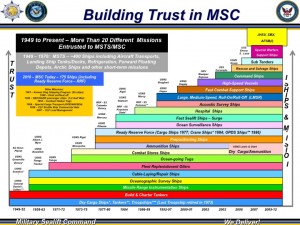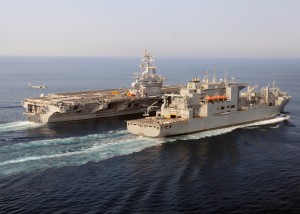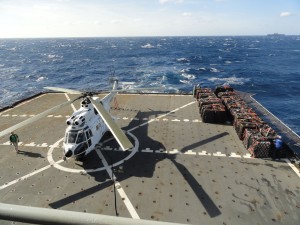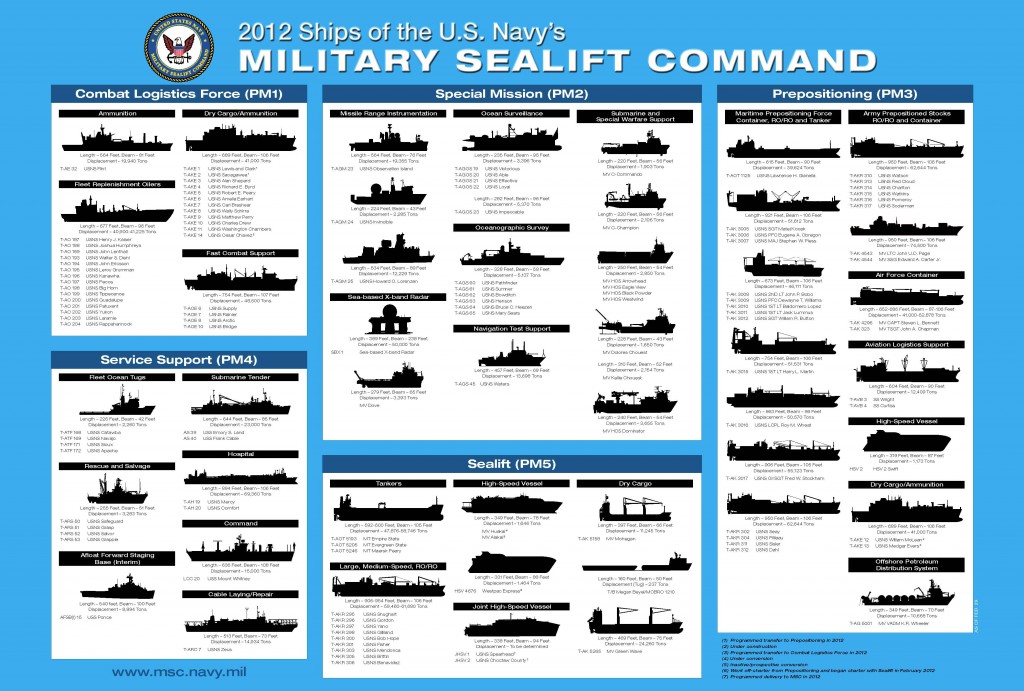5/5/2012 The Military Sealift Command is not the most visible element of the USN-USMC team, unless you are at sea and need their support. Whether support directly from the ships or from the air assets they fly to provide for vertical replenishment, the more than 100 MSC ships are the lifeblood of the fleet.
And in an era of tight budgets and challenges to fleet size, the ships of MSC are part of the solution to provide for enhanced fleet performance. Indeed, the recent landing of a V-22 Osprey on a T-AKE MSC ship was an eye opener of how the roles of these ships can change, as the air assets change. The intersection between the air and surface assets was highlighted once again with regard to the dynamics of change.
In a wide-ranging discussion with the Commander of MSC, Admiral “Buz” Buzby provided an overview on the approach, capabilities and thinking about the future of MSC. The Admiral highlighted the scalability and flexibility of the command as well as the significant growth in the demand signal from the USN-USMC team over time. He underscored the challenges, which this demand side poses, especially as the Navy adds new ships like the LCS, which requires a significant enhancement of supply at sea requirements.
Rear Admiral Mark Buzby on the Approach of Military Sealift Command from SldInfo.com on Vimeo.
The Admiral underscored the importance of adding a new tanker to the fleet to replace today’s fleet oilers that are aging and single hulled. And the MSC is like other areas of the military being asked to do with equipment no one would use in the commercial domain. Double hull tankers are the norm in the industry for environmental and safety reasons; and clearly the MSC needs such capabilities as well for performance, safety and environmental reasons.
And finally, the Admiral identified for us an important example of how the flexibility of the Command helps the fleet in a different way: the rapid refurbishing of a core ship to enable the US and its allies to deal with Middle Eastern challenges was highlighted as well.
Above all, the Admiral underscored that MSC is a key player in what has been called by some the National Fleet. Indeed, as one rethinks littoral engagements, the infrastructure of support is not only a foundational element it is a core participating and enabling engagement force.

The Admiral has an unusual background for a USN Admiral, although one most appropriate to being the Commander of MSC.
Admiral Buzby: I’m a 33-year Navy veteran. I attended the U.S. Merchant Marine Academy, and I’m the only flag officer on active duty who graduated from the Merchant Marine Academy. I’m the first Maritime Academy graduate to head Military Sealift Command. But this position is a very comfortable place for me to be. Although I spent all of my previous professional Navy time on Cruisers and Destroyers, my roots were in the Merchant Marine. My roots were in the maritime industry, and I maintain my Coast Guard Merchant Marine license to this day.
It’s always been an important part of my background and my thinking as I’ve operated in the surface fleet is that the supply ship on the other end of the span-wire was much more to me than just the source of my fuel and food, and bullets.
Typically, the captain who was driving was a classmate or someone I knew.
As a result, I feel uniquely positioned in that I know both sides of the coin or the entire coin, let us say, pretty well.
And during my two and a half years in command, I have been able to visit my entire MSC fleet. We have over 100 ships and I am currently working on getting around again.
SLD: Could you talk about your fleet of ships and the challenges of operating the fleet?
Admiral Buzby: MSC has seen its mission sets expand over time, to today when we have 20 missions. The demand signal is growing; the resources are not. And we operate a very diverse fleet, of varying ages and unique requirements. This places significant challenges for sustainability as well as training crews for specialized ships.
We operate 58-year-old steam plants all the way up to gas turbine water jet, 38-knot ships, and everything in between. We operate diesel- electric, geared-diesel, gas turbine, you name it, if it is out there, we operate it. It is a very diverse fleet.
The Challenge of Vertical Replenishment at Sea from SldInfo.com on Vimeo.
SLD: And I am sure the diversity is also driven by the variant ages of the ships and provides a picture somewhat like a geological age chart?
Admiral Buzby: It is. If it is out there, we have to maintain and operate it. And there is the training challenge as well. We need to keep people trained to operate a wide variety of different equipment. Some of the equipment we need to keep around because of its very unique capability.
SLD: We will return to a discussion of your fleet and modernization challenges in a moment. But could we focus on the mission sets and the demand signal facing MSC?
Admiral Buzby: MSC and its predecessor Military Sea Transportation Service came about in 1949 when four different shipping agencies, if you will, were put together post-war. All of those were put together to form military sea transportation service, which in those days was troop ships, and point-to-point tankers. They weren’t servicing the fleet; they were hauling from point A to point B.
And then, in 1972, when the first fleet replenishment oiler was given to MSC – USS TALUGA (AO 62), the Navy decided to experiment with the MSC, in effect. The great experiment was to see if civilian mariners could pump fuel across 120 feet of water without spilling any or bumping into the ship there alongside. And sure enough, not only could they do it; they were doing it more efficiently and for a fraction of the cost.
From those humble beginnings, other ships were added. Oilers were joined over time by cable layers, range tracking ships, tugs, ammo ships, fast combat store ships, ocean surveillance ships, hospital ships, prepositioning ships, survey ships, and the list has now gone to 20 missions. That’s 20 missions for the Navy that used to be operated by Blue Jackets.
And we’re getting additional missions all the time. On April 16th, we will put into commission n interim a forward staging base or AFSB. A former Navy LPD, the USS PONCE, which was about to be decommissioned after 41 years of service, a fine asset of the Naval Surface Force Atlantic is being turned over to MSC to operate. The ship will still be a USS with a Navy Captain 06 in command, but she has 149 Mariners on there doing the vast majority of the work with 49 Navy sailors onboard to do those things that by law only Navy sailors can do, such as fire weapons and perform the offensive missions.

SLD: Let us return to a discussion of your fleet. What are your latest acquisitions?
Admiral Buzby: The JHSV or Joint High Speed Vessel is the latest tool in the kit. It is primarily built for intra-theater lift. Think of it as a big, fast box or a seaborne C-130. It is a $250 million LCS without guns.
SLD: What is your biggest need right now for fleet modernization?
Admiral Buzby: Without doubt it is tanker replacements. I would like a new class of tanker, which would be a double hull tanker. All my tankers are single hull except for three. The first ship in the tanker replacement program is in the Navy POM for FY16 and that would mean that the first ships would arrive no earlier than 2020 or so. The design has not been decided nor announced but we would need 15 of the new tankers to replace the current fleet.
We need about a 20-knot ship that’s sized about the same as the class it would replace so we can get into ports pretty easily. We don’t want to draw more than around 30 – 35 feet. They would be double-hulled and would most likely operate with diesel engines.
SLD: Let us discuss your T-AKE ships, which were prominently featured in Bold Alligator 2012. These seem very capable ships. How are they affecting fleet operations?
Admiral Buzby: They are a ship class that’s replacing two other ship classes: ammunition ships and dry stores ships. Although there will be 14 T-AKE ships, MSC will have 11 and these 11 are replacing those two other classes of ships.
The T-AKEs are our largest program right now, but it’s just coming to its conclusion. The 14th and the last ship will launch on the 5th of May in San Diego, which will actually be the last big uncontrolled stern launch that gets done in our country. That is the last time because NASSCO and most other Tier 1 yards build in graving docks or on land level facilities. So, this will be the last big stern sliding launch.
The other three T-AKE ships will go to the Marines.
SLD: What are the Marines going to use the T-AKE ships for?
Admiral Buzby: Those ships are destined to be part of the Maritime Prepositioning Force (MPF) squadrons; one for each squadron.
The idea under the old MPF future construct, this was going to be the ship that carried the munitions and a lot of the dry cargo supplies to relieve some of the other MPF shipping. They can carry other material and basically have a more open stowage plan on those ships. Because the problem with the MPF squadrons is they’re administratively loaded.
So, if you want to do breakout, the T-AKE ship has the space to access the load quickly. Currently, on an MPF ship, if you have the HADR package that’s down in the bottom number three hold, and you’ve got Abrams tanks and two decks of Humvees and everything else on top of them, it will be difficult to get to them. You just can’t reach in and grab.
And even with RFID tags on it that tells you exactly where it is, it is still down there buried under four decks of stuff.
The Marines have always asked for ships large enough, with enough extra space, which is expensive, so that you can move stuff out of the way and get the things that you need right now.
And the Marines will add some additional communications gear on their ships to facilitate their operations as well.
SLD: We talked with Captain John Little of the USNS Robert Peary about the Osprey landing on the T-AKE ship. But the Osprey is too big for the hangers and would need to be tied down on the deck to be part of the operation.
Admiral Buzby: Correct. The Hangars are sized for an H-60 or Puma helicopter. It would be very unlikely that you would see an Osprey permanently assigned to the ship.
SLD: The T-AKE ship does provide for a very flexible capability when paired to a ship like the National Security Cutter. Could you provide a sense of the kind of flexibility such a pairing might provide?
Admiral Buzby: The national security cutters have an embarked helicopter, some firepower and some good command-and-control. Pair it up with a T-AKE, and you can have presence and staying power for a regional security mission.
With the NSC-T-AKE pairing you have sustainment for the security cutter. You’ve given it legs because it’s got a million gallons of fuel sitting across the way there. It’s got more supplies than they’ll ever use in their world, and plus ammo and storage and everything else. Plus, if you’re not carrying a whole hold full of ammo, there’s three or four decks worth of magazine space up there in that hold as well.
And let us just say you wanted to carry some light-combat vehicles for the operation, you could put easily probably 30 vehicles on that deck. Plus, you could probably store below another at least 15 using the elevators.
Plus you have onboard cranes to offload them pier-side if you needed to, or off onto a lighter. You got ten-ton cranes on both sides of the deck area. And if you were operating in such a way that you had helo lift or V-22, you could lift the vehicles off the deck and put them ashore someplace. Or go pier-side and self unload.
You could put a couple platoons of marines onboard there easily. More if you wanted to stretch it out a little bit. There’s room to put them down below. It’s got a good comms suite on the NSC and it’s got the legs to stay out there for a long time and sustain itself in that configuration.

So, all of a sudden you’ve got a pretty big footprint that’s pretty self-sustainable that can make a significant impact in a lot of different ways.
And using a strictly Navy pairing, you could plug in the LCS for the security cutter if you wanted a more tailored capability using one of the embarked mission modules. There’d be tradeoffs, obviously, back and forth there for what it could do or what it couldn’t do. But those two could work together very well I think.
SLD: Speaking of the LCS, and the question of the demand side posed by deployed LCS’s, how will they impact on your workload? It probably depends on how the LCS is deployed, because if it is dispersed that would be challenging for the MSC fleet.
Admiral Buzby: It’s going to make us very busy. We’re busy now; it’s going to make us even busier. And those particular ships have one refueling station, and they have no connected replenishment, so the only way they can get their supplies at sea is via vertical replenishment on the flight deck.
SLD: An aspect of the MSC we noted in the operations off of Libya was that you work closely with allies as well.
Admiral Buzby: We have allied customers all of the time. You go aboard any one of my ships and look in the passageways; you’ll see plaques from every country. Our equipment is all NATO-standard.
SLD: MSC is an unusual command for the USN and operates more on commercial than a military model of procurement and acquisition. Could you talk about the Command’s business model?
Admiral Buzby: The really unique aspect, I think, of Military Sealift Command is our agility and our flexibility. And that’s a result of our business model, which is primarily commercial in its foundation.
We operate much like a civilian shipping company does. However, obviously, our roots are in the Navy.
We harvest the best of both worlds in that respect. We are very close to the fleet; we support the fleet directly, but we have 20 missions all together across MSC that span the realm from very close support to sealift missions, carrying material from point A to point B, which is very similar to the commercial world.
That model is scalable and with the authorities that I am given in my role as a commander of MSC, I have a contracting authority and chartering authorities that enable me to take rapid advantage of the best maritime solution for the mission that we’re given.
Whether it is using one of my government-owned ships, or whether it’s using a contractor owned and operated ship, or a government ship that I have a contractor operate for me.
I can come up with the best solution to give the most cost effective means to the government to execute a mission and can use either a government-owned ship or a contractor owned and operated ship.
And each mission is a little bit different. This gives us the great ability to provide a good solution to the government and to our customers.
SLD: Clearly a notable example of the contracting flexibility and agility of the MSC has been the case of putting the USS Ponce back to sea. Could you talk about this case study?
Admiral Buzby: I think it’s quite telling and a real tribute to Admiral Harvey that he understands what MSC can bring to the table. He understood that he could take an existing fleet asset, a Navy LPD, an assault amphibious vessel, and convert it something else via MSC.
The USS Ponce was to be decommissioned at the end of March of 2012. A 41-year-old ship had reached the end of its normal service life. He came to MSC and asked whether our mariners could operate this ship as an afloat forward staging base.
We don’t have an afloat forward staging base in MSC. But I told him, Admiral, we can do that. And we can refurbish this ship under the authorities that I have to go out and contract for maintenance and repair and I can do that very quickly for you.
I can give you a very high value for your dollar, which I know are limited to do this. And we can deliver you a capability in a very short amount of time operated by my mariners, primarily, with some Navy uniform folks doing those missions that the Navy must do.
But I can give you that capability probably faster than anyone else. And I’m very proud to say we’re going to deliver that capability on time, and on budget, and it’s going to go out there and I have every belief that it’s going to hit it out of the park and be a real force multiplier.
For additional stories focusing on the MSC and related issues see the following:
https://sldinfo.com/tak-ing-the-supply-ship-to-a-whole-other-level/
https://sldinfo.com/the-osprey-and-the-usns-robert-e-peary-in-bold-alligator/
The featured image shows the Osprey aboard the T-AKE ship during Bold Alligator 2012. Credit: USN.
For a comprehensive look at the maritime security threats facing the global economy in 2012 see the report by our partners Risk Intelligence
https://sldinfo.com/products/february-2012-si/


